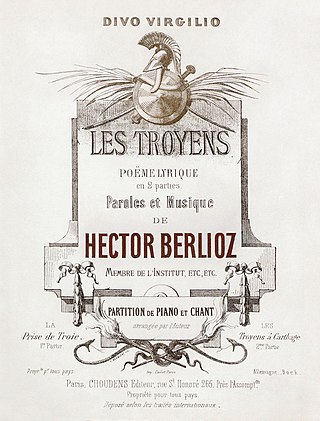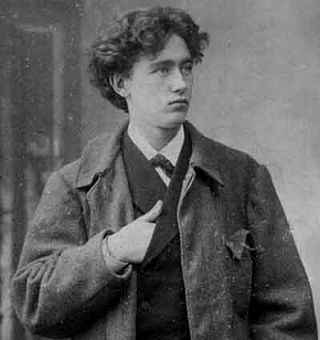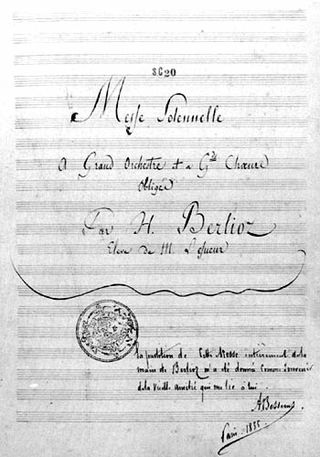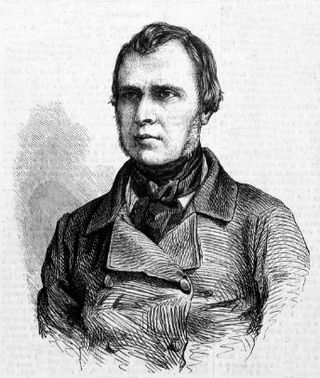Related Research Articles

Louis-Hector Berlioz was a French Romantic composer and conductor. His output includes orchestral works such as the Symphonie fantastique and Harold in Italy, choral pieces including the Requiem and L'Enfance du Christ, his three operas Benvenuto Cellini, Les Troyens and Béatrice et Bénédict, and works of hybrid genres such as the "dramatic symphony" Roméo et Juliette and the "dramatic legend" La Damnation de Faust.

Symphonie fantastique: Épisode de la vie d'un artiste … en cinq parties Op. 14, is a programmatic symphony written by Hector Berlioz in 1830. The first performance was at the Paris Conservatoire on 5 December 1830.

Charles Munch was an Alsatian French symphonic conductor and violinist. Noted for his mastery of the French orchestral repertoire, he was best known as music director of the Boston Symphony Orchestra.

Roméo et Juliette is a seven-movement symphonie dramatique for orchestra and three choruses, with vocal solos, by French composer Hector Berlioz. Émile Deschamps wrote its libretto with Shakespeare's play as his base. The work was completed in 1839 and first performed on 24 November of that year, but it was modified before its first publication, in 1847, and modified again for the 2ème Édition of 1857, today's reference. It bears the catalogue numbers Op. 17 and H. 79. Regarded as one of Berlioz's finest achievements, Roméo et Juliette is also among his most original in form and his most comprehensive and detailed to follow a program. The vocal forces are used in the 1st, 5th and 7th movements.

La damnation de Faust, Op. 24 is a work for four solo voices, full seven-part chorus, large children's chorus and orchestra by the French composer Hector Berlioz. He called it a "légende dramatique". It was first performed at the Opéra-Comique in Paris on 6 December 1846.

Benvenuto Cellini is an opera semiseria in four tableaux by Hector Berlioz, his first full-length work for the stage. Premiered at the Académie Royale de Musique on 10 September 1838, it is a setting of a libretto by Léon de Wailly and Henri Auguste Barbier, who invented most of the plot inspired by the memoirs of the Florentine sculptor Benvenuto Cellini. The opera is technically challenging and was until the 21st century rarely performed. But its overture sometimes features in orchestral concerts, as does the concert overture Le carnaval romain which Berlioz composed from material in the opera.

Les Troyens is a French grand opera in five acts, running for about five hours, by Hector Berlioz. The libretto was written by Berlioz himself from Virgil's epic poem the Aeneid; the score was composed between 1856 and 1858. Les Troyens is Berlioz's most ambitious work, the summation of his entire artistic career, but he did not live to see it performed in its entirety. Under the title Les Troyens à Carthage, the last three acts were premièred with many cuts by Léon Carvalho's company, the Théâtre Lyrique, at their theatre on the Place du Châtelet in Paris on 4 November 1863, with 21 repeat performances. The reduced versions run for about three hours. After decades of neglect, today the opera is considered by some music critics as one of the finest ever written.

Paul Felix Weingartner, Edler von Münzberg was an Austrian conductor, composer and pianist.

Harold en Italie, symphonie avec un alto principal, as the manuscript describes it, is a four-movement orchestral work by Hector Berlioz, his Opus 16, H. 68, written in 1834. Throughout, the unusual viola part represents the titular protagonist, without casting the form as a concerto. The movements have these titles, alluding to a programme:
- Harold in the mountains
- March of the pilgrims
- Serenade of an Abruzzo mountaineer
- Orgy of bandits
The Orchestre de la Société des concerts du Conservatoire was a symphony orchestra established in Paris in 1828. It gave its first concert on 9 March 1828 with music by Beethoven, Rossini, Meifreid, Rode and Cherubini.

Les nuits d'été, Op. 7, is a song cycle by the French composer Hector Berlioz. It is a setting of six poems by Théophile Gautier. The cycle, completed in 1841, was originally for soloist and piano accompaniment. Berlioz orchestrated one of the songs in 1843, and did the same for the other five in 1856. The cycle was neglected for many years, but during the 20th century it became, and has remained, one of the composer's most popular works. The full orchestral version is more frequently performed in concert and on record than the piano original. The theme of the work is the progress of love, from youthful innocence to loss and finally renewal.
Francis Travis was an American-born Swiss orchestral conductor.

Messe solennelle is a setting of the Catholic missa solemnis by the French composer Hector Berlioz. It was written in 1824, when the composer was twenty, and first performed at the Saint-Roch, Paris, on 10 July 1825, and again at the Saint-Eustache in 1827. After this, Berlioz claimed to have destroyed the entire score, except for the Resurrexit, but in 1991 a Belgian schoolteacher, Frans Moors, came across a copy of the work in an organ gallery in Antwerp, and it has since been revived.

A choral symphony is a musical composition for orchestra, choir, and sometimes solo vocalists that, in its internal workings and overall musical architecture, adheres broadly to symphonic musical form. The term "choral symphony" in this context was coined by Hector Berlioz when he described his Roméo et Juliette as such in his five-paragraph introduction to that work. The direct antecedent for the choral symphony is Ludwig van Beethoven's Ninth Symphony. Beethoven's Ninth incorporates part of the ode An die Freude, a poem by Friedrich Schiller, with text sung by soloists and chorus in the last movement. It is the first example of a major composer's use of the human voice on the same level as instruments in a symphony.
Hugh John Macdonald is an English musicologist chiefly known for his work within the music of the 19th century, especially in France. He has been general editor of the Hector Berlioz: New Edition of the Complete Works since its inception in 1967 and has been particularly active in the revival of interest in Berlioz's music. He is also the author of several entries within The Grove Dictionary of Music and Musicians.

Narcisse Girard was a French violinist, conductor and composer.
Friedrich Hofmeister Musikverlag is a publisher of classical music, founded by Friedrich Hofmeister in Leipzig in 1807. Early listings included composers Ludwig van Beethoven, Frédéric Chopin and Franz Liszt. Hofmeister was the first to publish Mahler's Second Symphony. Pedagogical works, such as a Violinenschule of Hubert Ries (1841), are still in use. The company sells sheet music internationally, including Asia and America.

Charles Théodore Malherbe was a French violinist, musicologist, composer and music editor.

Joseph Louis d'Ortigue was a French musicologist and critic. A specialist in liturgical music and a conservative Catholic of ultramontane and royalist leanings, he was a close friend of both Berlioz and Liszt. His most influential work was Dictionnaire liturgique, historique, et theorique de plain-chant et le musique d'église, but he also wrote for many of the most prominent periodicals of the day, including Journal des débats and Le Ménestrel where he was the editor-in-chief from 1863 until his sudden death at the age of 64.
References
- 1 2 3 Slonimsky, Nicolas and Kuhn, Laura (2005)."Holoman, D(allas) Kern". Baker's Biographical Dictionary of Musicians , via HighBeam Research.
- ↑ UC Davis Department of Music. "D. Kern Holoman bio". Archived from the original on 23 September 2014. Retrieved 5 July 2016.
- ↑ Ronayne, Kathleen (13 December 2017 "Former UC Davis professor, conductor accused of sex assault". Associated Press via San Francisco Chronicle . Retrieved 17 December 2017.
- ↑ American Musicological Society (14 December 2017). "Action taken by the AMS Board of Directors". Retrieved 17 December 2017.